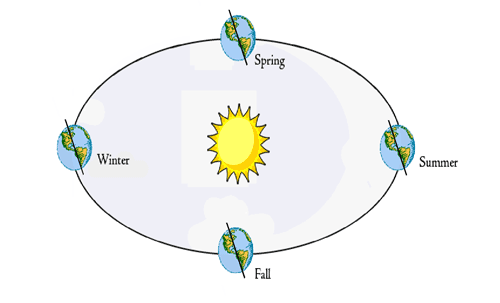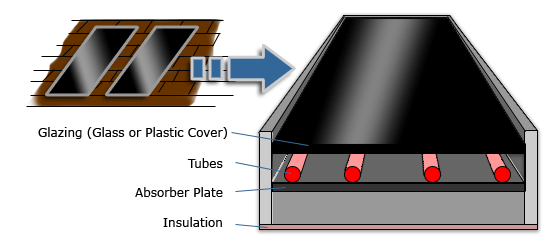8.9: Cooling and Heating (V)
- Page ID
- 50385
Solar Energy for Home Heating
Energy that is received on the roof of a house is more than enough to supply the heating needs of the home. The energy reaching the earth from the sun ranges from 600 to 2000 BTUs per square foot per day (averaged over a year). It is a function of the latitude of the place. The amount of solar radiation reaching the earth is called the insolation. This is a short from for incident solar radiation per day.
The earth revolves around the sun with its axis tilted toward the plane of rotation, as shown in Figure 8.9.1.
- In June, the North Pole is tilted toward the sun and the solar rays are incident perpendicularly. Therefore, the sun appears to be at a higher angle.
- In December, the North Pole is tilted away from the sun and therefore days are shorter and the solar rays are incident more obliquely, with lower energy flux (winter).

Figure 8.9.1. Illustration of seasons for northern hemisphere
The sun also changes in position and angle from the earth during various times of the year.
The following video shows the movement of the sun as a function of the seasons.
Active Solar Heating Systems
Solar heating systems are classified as “active” or “passive” solar heating systems, or a combination of both. We will first look at active systems.
Active solar heating systems are comprised of collectors, a distribution system, and a storage device.
Active solar heating systems operate as follows:
- Flat plate collectors are usually placed on the roof or ground in the sunlight. The top or sunny side has a glass or plastic cover to let the solar energy in. The inside space is a black (absorbing) material to maximize the absorption of the solar energy.
- Cold water is drawn from the storage tank by pump #1 and is pumped through the flat plate collector mounted on the roof of the house.
- The water absorbs the solar energy and is returned back to the tank.
- Warm water from the tank is pumped by pump #2 though the heating coil.
- The fan blows air (from the room) over the heated coil, and the heated air then passes into the room and heats the room.
- Cold air sinks to the bottom and is re-circulated over the heating coil.
Note: The standby electric coil is automatically turned on and provides the heat when the water temperature to the heating coil drops because of consecutive cloudy days.
The following video shows the operation of an active solar heating system.
Collector’s efficiency is the ratio of solar radiation that is captured and transferred to the collector or heat transfer fluid.
The efficiency of a collector, depicted in Figure 8.9.2, can be expressed as
\[ Collector's \, Efficiency = \dfrac{Useful \, energy \, delivered}{Isolation \, on \, collector} × 100% \]
Typical collector efficiencies range from 50–70%.

Figure 8.9.2. Solar plate collector
Passive Solar Heating System
Passive systems do not use mechanical devices such as fans, blowers, or pumps to distribute solar heat from a collector. Instead, they take advantage of natural heat flow to distribute warmth. An example of a passive system for space heating is a sunspace or solar greenhouse.
Passive systems also make use of materials with large heat capacities (stone, water, or concrete) to store and deliver heat. These are called thermal masses.
Passive systems can be categorized into three types:
- Direct Gain - Allows the solar energy to come in through the south-facing window panes.
- Indirect Gain - Allows the solar radiation to heat a wall and then the energy is slowly delivered into the interior of the house. Openings in the wall (called a Trombe Wall), as shown in the figure below, promote convective currents:
- Cold room air enters the space between the glass panel and the wall through the bottom opening.
- As this cold air gets heated, it rises to the top and comes in through the top opening.
- Greenhouse Addition - An attached sunspace and/or solar greenhouse heated by the solar energy - where some of the energy is used to grow the plants and some of it is used to heat the interior of the house.
These systems are shown in Figure 8.9.3.

Figure 8.9.3. Illustration of the 3 types of passive systems
Costs and Benefits
It is usually most economical to design an active system to provide 40 to 80 percent of the home’s heating needs. Systems providing less than 40 percent of the heat needed for a home are rarely cost-effective except when using solar air heater collectors that heat one or two rooms and require no heat storage.
A well-designed and insulated home that incorporates passive solar heating techniques will require a smaller and less costly heating system of any type, and may need very little supplemental heat other than solar.
The cost of an active solar heating system will vary. A simple window air heater collector can be made for a few hundred dollars. Commercial systems range from $30 to $80 per square foot of collector area, installed. Usually, the larger the system, the less it costs per unit of collector area. Commercially available collectors come with warranties of 10 years or more, and should easily last decades longer.
Additional information
Heating your home with an active solar energy system can significantly reduce your fuel bills in the winter. A solar heating system will also reduce the amount of air pollution and greenhouse gases.

